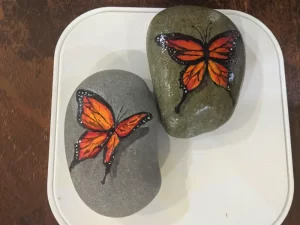Ever wondered how to turn those rough stones into a perfectly smooth canvas? Look no further! In this article, we’ve compiled seven methods, ranging from the familiar to the unconventional, that will help you achieve flawlessly smooth rocks for your next painting adventure!
To achieve smooth surfaces on rough stones for painting, fill shallow bumps with DIY filler or wood filler, larger holes with spackle, and deep holes with clay. For quick fixes, consider play dough. Finish it off with sanding if needed and or apply a basecoat to further enhance smoothness.

If you are excited to create some awesome rock art but the ones you got either have holes or are rough. In this blog post, we will explore these different methods for smoothing stones before painting. We’ll discuss how to use them and all the pros and cons of each method.

1. DIY Filler to Smoothen Rough Stones (Glue + Cornstarch)
Let’s start with a weird option, mod podge(glue) with cornstarch. Since I have them at hand, I tried using them to smoothen a rough stone. I had a hint that this will work since I’ve already used this mixture for a fun canvas painting (textures) before.
With this rock experiment; the glue and powder mixture did not disappoint! This DIY concoction can smoothen rocks with tiny, shallow bumps like a wood filler can(as you can see in the picture above). You can also use white glue instead of mod podge, or talc/powder chalk instead of cornstarch.
How to Use DIY Filler to Smoothen Rough Rocks
First, add a few drops of glue or mod podge to the rough surface of the stone, then add a pinch or 2 of cornstarch. Using your finger (with gloves or plastic), mix and rub it to the rough surface until it is all smooth. Let it dry, then apply the base coat or primer.
If you will be working with lots of stones, you can also just make the mixture in a small container, just combine 1 part glue with 1 part cornstarch, test it, and adjust the ratio if needed.
Pros of Using DIY Filler to Smoothen Rocks
The glue and powder mixture worked with the rough stone that has tiny, shallow bumps. It is super convenient if you already have cornstarch and mod podge (or white glue) at home. No wastage, because you can use them in other ways too. It’s also fairly easy to use.
Cons of Using Glue to Smoothen Rocks
As for the disadvantage, I’m really not sure how stable it is. Especially if the rocks are to be displayed outdoors.
Also, while it could potentially(I haven’t tried) work with deep, large holes; it could be time-consuming and complicated to apply and dry. You might need to add more starch and fill and dry one thin layer at a time.
2. Wood Filler on for Rock/Stone Painting
Now if you don’t have time for some DIY mixing, you can use a store-bought wood filler. It’s a popular option for smoothing stones or rocks before painting. And for good reasons.
How to Apply Wood Filler on Rocks for Painting?
To apply, squirt some filler on the surface of the rock. Use your hands with gloves to fill in any cracks or imperfections on the stone’s surface, and spread it until smooth. Let it dry, then sand it with fine sandpaper if needed. Apply a coat of primer or basecoat.
*Always check the product label for safe and proper use.
Example: LePage Wood Filler
Pros of Wood Fillers on Rocks
My favorite thing about wood fillers is that it is super easy to use. Because it has a spreadable consistency, it can easily fill in tiny cracks, chips, or imperfections on the surface of the stone.
Another advantage of wood filler is that it’s durable. Once the wood filler dries and hardens, it provides a solid surface. This ensures that your painted design will adhere well and last long. They are also easy to find online or at your nearest hardware store.
Cons of Wood Fillers on Rocks
Wood fillers have some disadvantages. One is that you may need to work in a well-ventilated area and wear a mask and gloves while working with it. Also, you must wait 3 to 24 hours for it to dry.
Another con is it could get expensive if you use it on huge rocks or those with big deep holes. This is also significant if you have lots of stones to patch.
3. Spackle to Fill Gaps and Holes on Rocks
Spackle is another popular choice for filling holes or cracks and smoothening rocks/stones.
How to Use Spackle on Rocks Before Painting?
Apply the spackle using a knife. You can then use your hand (with gloves) to smoothen it. After applying the spackle, allow it to dry completely before sanding it down with fine-grit sandpaper. Then apply the basecoat or primer.
Example: DryDex Spackling
Pros of Using Spackle on Rocks
Spackle is suitable for filling larger holes, deep cracks, or uneven surfaces. It usually dries faster than wood filler.
Cons of Using Spackle on Rocks
I find that spackle is a bit harder to apply than wood filler because of its thicker consistency. It can also be messy to sand, so be prepared to clean up afterward. It’s advisable to wear protective gloves and mask and work in a well-ventilated area.
Another disadvantage is it can start to dry quickly in the container, which can lead to wastage. To prevent this, work efficiently and cover the container very tightly when not in use.

4. Using Clay to Fill Gaps on Rocks for Painting
No-bake natural clay can be used to fill in huge, deep holes in rocks. It can be used the same way as spackle.
How to Use Clay to Fill Holes and Gaps on Rocks
To use clay for filling holes and gaps on rocks, softened the clay with your hand. Press it firmly into the gap. Smooth the surface and let it completely dry. Sand as necessary before priming.
You can play around, and add a tiny bit of water to adjust the consistency.
*Make sure to use no-bake clay, since it’s not safe to bake rocks or stones.
Example: Activa Air-Dry White Clay
Pros of Using Clay on Rocks
What I love about using clay to fill in rocks is it’s easy and fun, even therapeutic, to work with. You can use it not just to fill in holes but also to add shape and texture. It can also be used to add a base to the rock so it can be displayed upright.
It also won’t break the bank! You can find clay at art supply stores or online without spending a fortune.
Cons of Using Clay on Rocks
There are a few things to keep in mind when using clay with rocks. First, clay takes some time to dry completely, so you’ll need to be patient before moving on to the painting stage.
Also, depending on the type of clay used, the filled areas can be a bit fragile and not as durable especially when exposed to harsh weather or frequent handling.
5. Play dough
Now this is another weird idea, play dough! If you’re looking for a quick fix, it can be used to fill in small gaps on stones as well. It works if you happen to have some at home(shoutout to the parents out there!).
How to Use Play Dough to Fill Gaps on Stones
Playdough can be used similarly to clay. But since it shrinks when it dries, you will need to apply more base coat to even out the remaining gap.
Pros of Using Play Dough on Stones
The good thing about play dough is it’s affordable. You can even make it at home, with recipes online, if you are up for that.
Cons of Using Play Dough on Stones
Here is one obvious disadvantage though. It will not be durable as it may shrink, chip, and crack. It’s also not as easy to apply and it takes a long time to completely dry before you can start priming.
6. Sanding Rock to Make it Smooth for Painting
Some of the methods above like using spackle and fillers need sanding, as I mentioned before. With much patience and elbow grease, raw natural rocks can also be sanded to make them smooth enough for painting.
How to Sand a Rough Stone for Painting?
Wet the rock and sandpaper, then sand in circular motions, gradually switching to finer grits until the rock feels smooth to the touch. Rinse off any residue and dry the rock before painting. The amount of time and effort you will need to sand the rock depends on how hard it is.
Some also use slab of concrete instead of sandpaper. Or you can use electric sander if you have one.
Pros
You won’t need to apply anything if you just directly sand a raw rock. It can be used to smoothen rough stones with small shallow bumps.
Cons
Sanding rocks can be time-consuming, especially with larger or irregularly shaped rocks, requiring patience and attention to detail. Additionally, the process generates dust and debris (which we dont want to inhale), and lots to cleanup (not our favorite either!).
It will be very hard to sand big rocks or very uneven surface.
7. Applying Primer or Basecoat to Make Rock Smooth
All the methods I mentioned above requires application of primer or basecoat. As I explained in another post on preparing rocks for painting, priming is a step I rarely skip. It has lots of benefits and that includes leveling the surface for painting. Priming also works by itself, for stones that have very minor shallow gaps to begin with.
Bonus Tips:
Start by Choosing the Right Rock
If you have the means to, just choose a smooth rock. It will make preparing the rock so much easier and you can get into painting sooner.
In another blog post, I took a deep dive on finding the best rock. There, I discussed all factors(including texture) and “whys” to consider when choosing. I also gave some ideas on where to find rocks.
Follow the Bumps
Now if you got some painting experience, you may want to be more adventurous. Just follow the natural bumps and shape of the rock. Who knows what interesting masterpiece you can come up with.
Happy painting!



